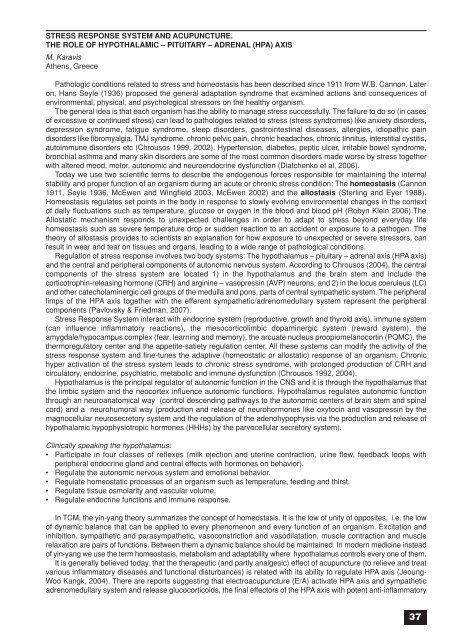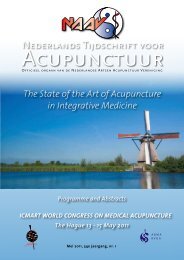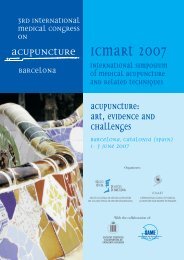Congress Abstracts full PDF - International Council of Medical ...
Congress Abstracts full PDF - International Council of Medical ...
Congress Abstracts full PDF - International Council of Medical ...
Create successful ePaper yourself
Turn your PDF publications into a flip-book with our unique Google optimized e-Paper software.
STRESS RESPONSE SYSTEM AND ACUPUNCTURE.<br />
THE ROLE OF HYPOTHALAMIC – PITUITARY – ADRENAL (HPA) AXIS<br />
M. Karavis<br />
Athens, Greece<br />
Pathologic conditions related to stress and homeostasis has been described since 1911 from W.B. Cannon. Later<br />
on, Hans Seyle (1936) proposed the general adaptation syndrome that examined actions and consequences <strong>of</strong><br />
environmental, physical, and psychological stressors on the healthy organism.<br />
The general idea is that each organism has the ability to manage stress success<strong>full</strong>y. The failure to do so (in cases<br />
<strong>of</strong> excessive or continued stress) can lead to pathologies related to stress (stress syndromes) like anxiety disorders,<br />
depression syndrome, fatigue syndrome, sleep disorders, gastrointestinal diseases, allergies, idiopathic pain<br />
disorders like fibromyalgia, TMJ syndrome, chronic pelvic pain, chronic headaches, chronic tinnitus, interstitial cystitis,<br />
autoimmune disorders etc (Chrousos 1999, 2002). Hypertension, diabetes, peptic ulcer, irritable bowel syndrome,<br />
bronchial asthma and many skin disorders are some <strong>of</strong> the most common disorders made worse by stress together<br />
with altered mood, motor, autonomic and neuroendocrine dysfunction (Diatchenko et al, 2006).<br />
Today we use two scientific terms to describe the endogenous forces responsible for maintaining the internal<br />
stability and proper function <strong>of</strong> an organism during an acute or chronic stress condition: The homeostasis (Cannon<br />
1911, Seyle 1936, McEwen and Wingfield 2003, McEwen 2002) and the allostasis (Sterling and Eyer 1988).<br />
Homeostasis regulates set points in the body in response to slowly evolving environmental changes in the context<br />
<strong>of</strong> daily fluctuations such as temperature, glucose or oxygen in the blood and blood pH (Robyn Klein 2006).The<br />
Allostatic mechanism responds to unexpected challenges in order to adapt to stress beyond everyday life<br />
homeostasis such as severe temperature drop or sudden reaction to an accident or exposure to a pathogen. The<br />
theory <strong>of</strong> allostasis provides to scientists an explanation for how exposure to unexpected or severe stressors, can<br />
result in wear and tear on tissues and organs, leading to a wide range <strong>of</strong> pathological conditions.<br />
Regulation <strong>of</strong> stress response involves two body systems: The hypothalamus – pituitary – adrenal axis (HPA axis)<br />
and the central and peripheral components <strong>of</strong> autonomic nervous system. According to Chrousos (2004), the central<br />
components <strong>of</strong> the stress system are located 1) in the hypothalamus and the brain stem and include the<br />
corticotrophin-releasing hormone (CRH) and arginine – vasopressin (AVP) neurons, and 2) in the locus coeruleus (LC)<br />
and other catecholaminergic cell groups <strong>of</strong> the medulla and pons, parts <strong>of</strong> central sympathetic system. The peripheral<br />
limps <strong>of</strong> the HPA axis together with the efferent sympathetic/adrenomedullary system represent the peripheral<br />
components (Pavlovsky & Friedman, 2007).<br />
Stress Response System interact with endocrine system (reproductive, growth and thyroid axis), immune system<br />
(can influence inflammatory reactions), the mesocorticolimbic dopaminergic system (reward system), the<br />
amygdale/hypocampus complex (fear, learning and memory), the arcuate nucleus proopiomelanocortin (POMC), the<br />
thermoregulatory center and the appetite-satiety regulation center. All these systems can modify the activity <strong>of</strong> the<br />
stress response system and fine-tunes the adaptive (homeostatic or allostatic) response <strong>of</strong> an organism. Chronic<br />
hyper activation <strong>of</strong> the stress system leads to chronic stress syndrome, with prolonged production <strong>of</strong> CRH and<br />
circulatory, endocrine, psychiatric, metabolic and immune dysfunction (Chrousos 1992, 2004).<br />
Hypothalamus is the principal regulator <strong>of</strong> autonomic function in the CNS and it is through the hypothalamus that<br />
the limbic system and the neocortex influence autonomic functions. Hypothalamus regulates autonomic function<br />
through an neuroanatomical way (control descending pathways to the autonomic centers <strong>of</strong> brain stem and spinal<br />
cord) and a neurohumoral way (production and release <strong>of</strong> neurohormones like oxytocin and vasopressin by the<br />
magnocellular neurosecretory system and the regulation <strong>of</strong> the adenohypophysis via the production and release <strong>of</strong><br />
hypothalamic hypophysiotropic hormones (HHHs) by the parvocellular secretory system).<br />
Clinically speaking the hypothalamus:<br />
• Participate in four classes <strong>of</strong> reflexes (milk ejection and uterine contraction, urine flow, feedback loops with<br />
peripheral endocrine gland and central effects with hormones on behavior).<br />
• Regulate the autonomic nervous system and emotional behavior.<br />
• Regulate homeostatic processes <strong>of</strong> an organism such as temperature, feeding and thirst.<br />
• Regulate tissue osmolarity and vascular volume.<br />
• Regulate endocrine functions and immune response.<br />
In TCM, the yin-yang theory summarizes the concept <strong>of</strong> homeostasis. It is the low <strong>of</strong> unity <strong>of</strong> opposites, i.e. the low<br />
<strong>of</strong> dynamic balance that can be applied to every phenomenon and every function <strong>of</strong> an organism. Excitation and<br />
inhibition, sympathetic and parasympathetic, vasoconstriction and vasodilatation, muscle contraction and muscle<br />
relaxation are pairs <strong>of</strong> functions. Between them a dynamic balance should be maintained. In modern medicine instead<br />
<strong>of</strong> yin-yang we use the term homeostasis, metabolism and adaptability where hypothalamus controls every one <strong>of</strong> them.<br />
It is generally believed today, that the therapeutic (and partly analgesic) effect <strong>of</strong> acupuncture (to relieve and treat<br />
various inflammatory diseases and functional disturbances) is related with its ability to regulate HPA axis (Jeoung-<br />
Woo Kangk, 2004). There are reports suggesting that electroacupuncture (E/A) activate HPA axis and sympathetic<br />
adrenomedullary system and release glucocorticoids, the final effectors <strong>of</strong> the HPA axis with potent anti-inflammatory<br />
37







